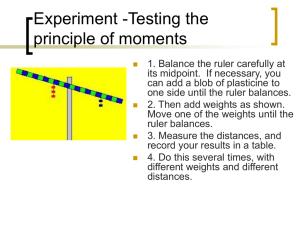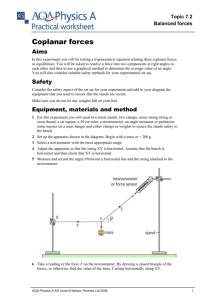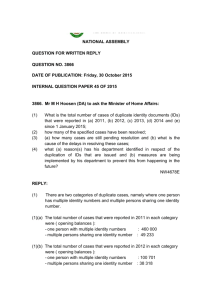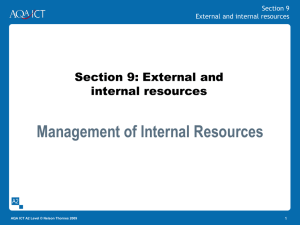Bridge Crane Moments: Physics Practical Worksheet
advertisement
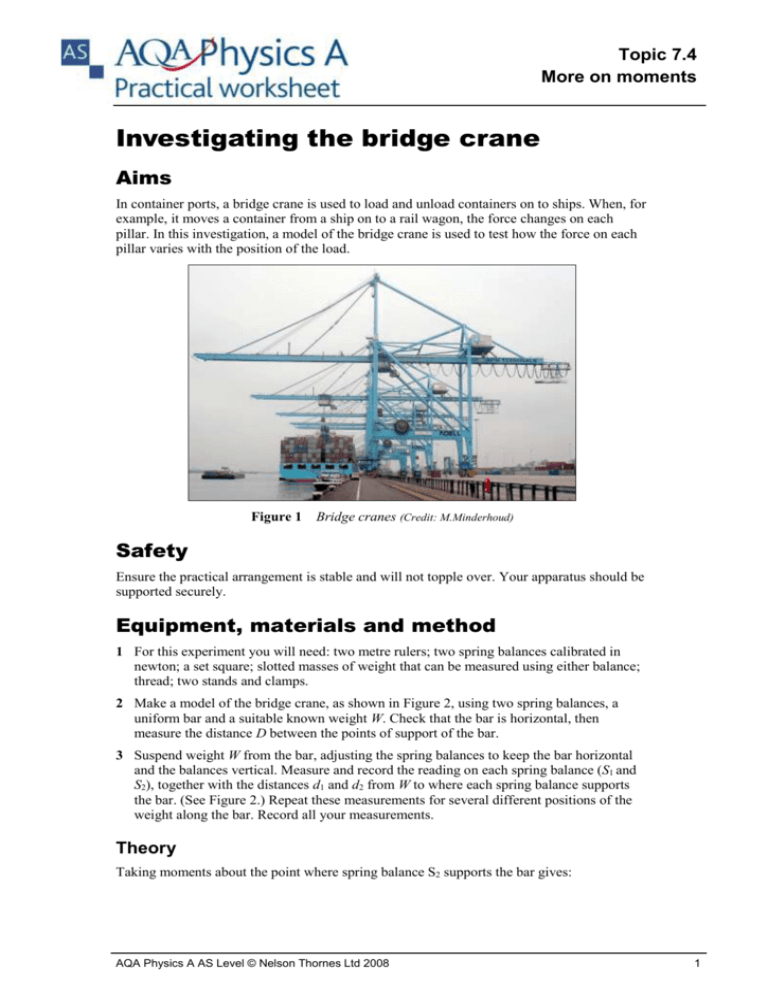
Topic 7.4 More on moments Investigating the bridge crane Aims In container ports, a bridge crane is used to load and unload containers on to ships. When, for example, it moves a container from a ship on to a rail wagon, the force changes on each pillar. In this investigation, a model of the bridge crane is used to test how the force on each pillar varies with the position of the load. Figure 1 Bridge cranes (Credit: M.Minderhoud) Safety Ensure the practical arrangement is stable and will not topple over. Your apparatus should be supported securely. Equipment, materials and method 1 For this experiment you will need: two metre rulers; two spring balances calibrated in newton; a set square; slotted masses of weight that can be measured using either balance; thread; two stands and clamps. 2 Make a model of the bridge crane, as shown in Figure 2, using two spring balances, a uniform bar and a suitable known weight W. Check that the bar is horizontal, then measure the distance D between the points of support of the bar. 3 Suspend weight W from the bar, adjusting the spring balances to keep the bar horizontal and the balances vertical. Measure and record the reading on each spring balance (S1 and S2), together with the distances d1 and d2 from W to where each spring balance supports the bar. (See Figure 2.) Repeat these measurements for several different positions of the weight along the bar. Record all your measurements. Theory Taking moments about the point where spring balance S2 supports the bar gives: AQA Physics A AS Level © Nelson Thornes Ltd 2008 1 Topic 7.4 More on moments S1D = Wd2 + Therefore: S1 = 1 W0D 2 1 W d2 + W0 D 2 A graph of S1 on the vertical axis against d2 on the horizontal axis should therefore be a 1 W straight line with a gradient and a y-intercept equal to W0. D 2 Figure 2 A model bridge crane Results Plot a graph of S1 against d2 to confirm the theory and use the graph to determine the weight W and the weight of the bar W0. AQA Physics A AS Level © Nelson Thornes Ltd 2008 2 Topic 7.4 More on moments Questions 1 (a) Explain how you checked the metre ruler was horizontal. (b) Use your graph to discuss the reliability of results. 2 (a) What is the most significant source of error in this experiment? (b) Discuss how you could reduce the most significant source of error. 3 A student who carried out this investigation forgot to check the spring balances for zero errors. (a) What is meant by a zero error? (b) What would be the effect on the graph of a zero error in one of the spring balances? AQA Physics A AS Level © Nelson Thornes Ltd 2008 3 Topic 7.4 More on moments Teaching Notes Aims To use simple measurements of distance and to apply the principle of moments to a model bridge crane. To relate practical measurements to straight line graph theory. To consider measurement errors and how to reduce them. Equipment and materials required Each group or pair of students will require the following equipment: two metre rulers two spring balances calibrated in newton a set square slotted masses of weight that can be measured using either balance thread scissors two stands and clamps graph paper Safety Ensure the practical arrangement is stable and will not topple over. 4 Remind the students to ensure that the spring balances are vertical and that the ruler is horizontal each time before they make their measurements. The students may need to be shown how to use a set square and a second metre ruler to carry out these tasks. 5 Students may need to be taken through straight line graph theory and how the general equation y = mx + c relates the theoretical equation for the bridge crane. 6 It is recommended that students carry out calculations in SI units in order to avoid confusion. Results The weight W should be equal to the gradient of the line D. The weight W0 should be equal to 2 the y-intercept. Answers to questions 1 (a) Use the second metre ruler to measure the vertical height (above the bench) of the horizontal ruler at each end. Use the set square against the bench (assumed horizontal) to check the second metre ruler is vertical. Adjust the clamps holding the horizontal ruler if necessary and recheck it is horizontal. Use the set square to check the spring balances are vertical. AQA Physics A AS Level © Nelson Thornes Ltd 2008 4 Topic 7.4 More on moments (b) The spread of the points about the line of best fit gives an indication of reliability. If the points are spread too much about the line of best fit, the results unreliable and the measurements should be repeated. 2 (a) Ensuring the ruler is horizontal and the spring balances are vertical each time the support forces S1 and S2 are to be measured. (b) Repeat each measurement at least twice for each position of the weight and calculate the mean value of each support force. 3 (a) The spring balance does not read zero when it is unloaded. (b) The gradient would be the same. The y-intercept would be different. Practical assessment opportunities 4 PSA – Selecting and using equipment: 0–3 marks (Following instructions and group work; organisation and safety assessed at end of course) 5 ISA preparation: practical task – practice in recording measurements and plotting a graph written task Section A and B – opportunities to discuss reliability and to analyse data and errors AQA Physics A AS Level © Nelson Thornes Ltd 2008 5
